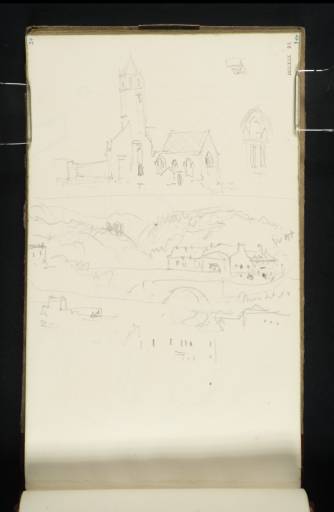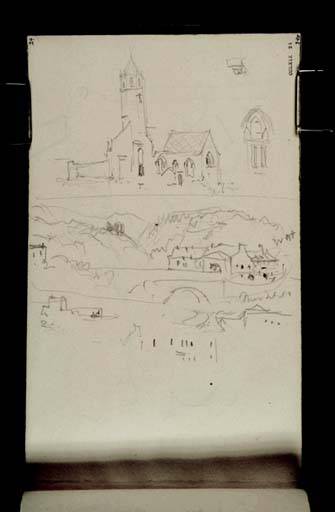Joseph Mallord William Turner St Bride's Church, Douglas, Lanarkshire; and a Village with a Bridge 1834
Image 1 of 2
Joseph Mallord William Turner,
St Bride's Church, Douglas, Lanarkshire; and a Village with a Bridge
1834
Joseph Mallord William Turner 1775–1851
Folio 24 Recto:
St Bride’s Church, Douglas, Lanarkshire; and a Village with a Bridge 1834
D26305
Turner Bequest CCLXIX 24
Turner Bequest CCLXIX 24
Pencil on off-white wove paper, 190 x 113 mm
Inscribed in pencil by Turner ‘wat’ | ?‘new bridge’ centre right
Inscribed in blue ink by John Ruskin ‘24’ top left running vertically and ‘340’ top right running vertically
Stamped in black ‘CCLXIX 24’ top right running vertically
Inscribed in pencil by Turner ‘wat’ | ?‘new bridge’ centre right
Inscribed in blue ink by John Ruskin ‘24’ top left running vertically and ‘340’ top right running vertically
Stamped in black ‘CCLXIX 24’ top right running vertically
Accepted by the nation as part of the Turner Bequest 1856
References
1909
A.J. Finberg, A Complete Inventory of the Drawings of the Turner Bequest, London 1909, vol.II, p.865, CCLXIX 24, as ‘Church, &c.’.
1990
Dr David Wallace-Hadrill and Janet Carolan, ‘Turner’s Sketches North of Stirling’, Turner Studies: His Art and Epoch 1775 – 1851, Vol.10 No.1, Summer 1990, p.12.
Turner passed through the village of Douglas during a journey around Lanarkshire on 19 September 1834. Along with the nearby Douglas Castle (folio 21 verso; D26300) the village of Douglas with its ruined church of St Bride’s was probably a site that Turner was asked to visit by Robert Cadell who had commissioned him to make illustrations to Sir Walter Scott’s Waverley Novels, including Castle Dangerous (1831) which featured the castle and church as locations. See Tour of Scotland for Scott’s Prose Works 1834 Tour Introduction.
At the top of the page, with the sketchbook turned to the left, is a view of St Bride’s Church from the churchyard to the east. The most distinctive feature of the building is the octagonal church tower. To the right of the tower is the chancel, and to the right of this Turner has included a diagram of what seems to be the smaller of the three windows on the southern wall (perhaps from inside the church) and a small study of one of the corbels that supports the roof. To the left of the tower is the ruined south aisle of the original building. There is a similar view of the church on folio 23 verso (D26304), and two pages of studies of its interior on folios 24 verso and 25 verso (D26306, D26308). Two sketches on folios 23 (D26303) and 23 verso may depict the village of Douglas with the church tower.
The sketch of a bridge with buildings and hills has not been firmly identified although the bridge over the River Clyde at Crossford is a possibility. David Wallace-Hadrill has suggested ‘Craigneith Bridge’,1 presumably referring to Crossfords. Another possibility is the three-arch stone bridge with a large stone gate at the end that crosses the River Clyde to Milton Lockhart, where Turner dined on 18 September. Although only one arch is visible in this sketch the sharp viewing angle may mean that the other arches are hidden by the nearside riverbank. Turner’s inscription could also read as a reference to the house (something like ‘Mil Lockt’). The buildings at the right, however, do not closely resemble the house with its many tall chimney’s and turrets.
Thomas Ardill
October 2010
How to cite
Thomas Ardill, ‘St Bride’s Church, Douglas, Lanarkshire; and a Village with a Bridge 1834 by Joseph Mallord William Turner’, catalogue entry, October 2010, in David Blayney Brown (ed.), J.M.W. Turner: Sketchbooks, Drawings and Watercolours, Tate Research Publication, December 2012, https://www


